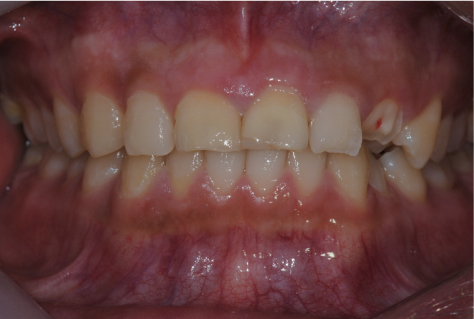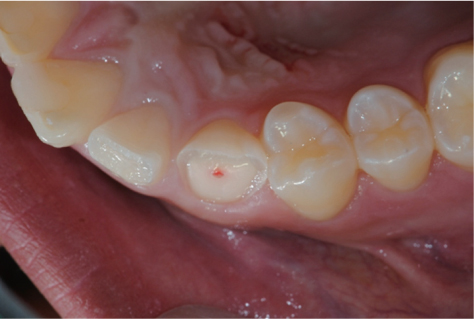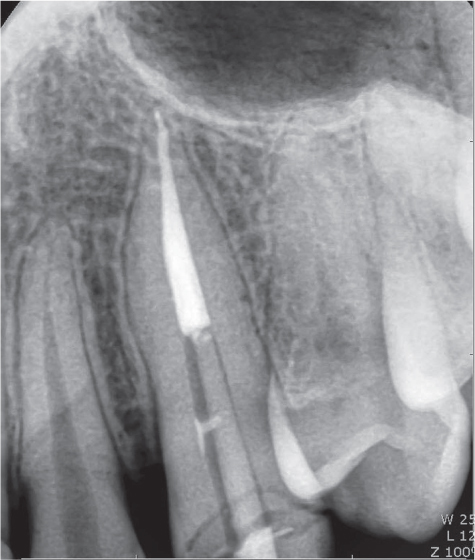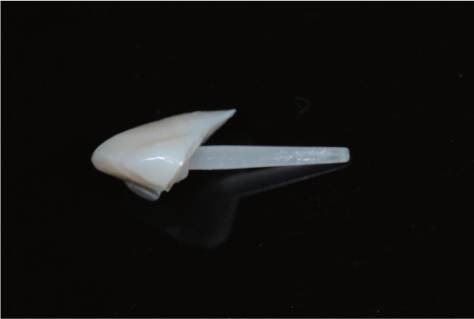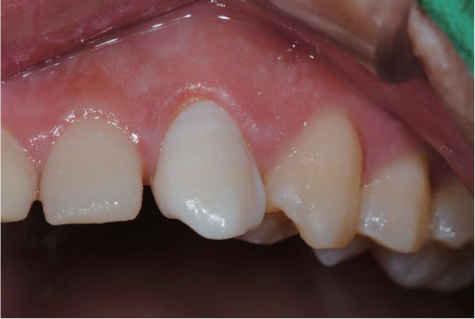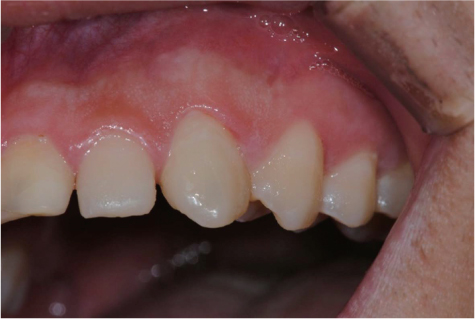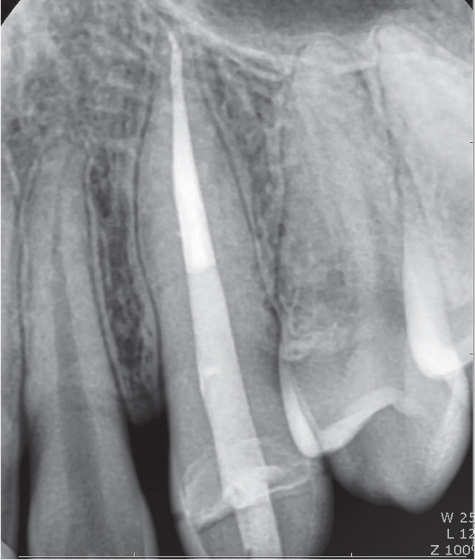Restor Dent Endod.
2014 Nov;39(4):324-328. 10.5395/rde.2014.39.4.324.
Reattachment of a fractured fragment with relined fiber post using indirect technique: a case report
- Affiliations
-
- 1Department of Conservative Dentistry, Chonbuk National University School of Dentistry, Jeonju, Korea. lkw@jbnu.ac.kr
- 2Institute of Oral Bioscience, Chonbuk National University, Jeonju, Korea.
- KMID: 2316915
- DOI: http://doi.org/10.5395/rde.2014.39.4.324
Abstract
- Although fiber-reinforced posts have been widely used, they sometimes fail to obtain sufficient retention because of an extremely large canal space. To address this, several techniques have been introduced including relining of the fiber-reinforced posts. Here, we used a relined glass-fiber post to increase retention and fitness to the root canal in a crown reattachment case. The relining procedure was performed by using an indirect method on the working cast. This case also highlights the esthetic concerns regarding dehydration of the attached crown fragment.
Keyword
MeSH Terms
Figure
Reference
-
1. Išeri U, Özkurt Z, Kazazoğlu E. Clinical management of a fractured anterior tooth with reattachment technique: a case report with an 8-year follow up. Dent Traumatol. 2011; 27:399–403.
Article2. Lauridsen E, Hermann NV, Gerds TA, Kreiborg S, Andreasen JO. Pattern of traumatic dental injuries in the permanent dentition among children, adolescents, and adults. Dent Traumatol. 2012; 28:358–363.
Article3. Macedo GV, Diaz PI, De O Fernandes CA, Ritter AV. Reattachment of anterior teeth fragments: a conservative approach. J Esthet Restor Dent. 2008; 20:5–18.
Article4. Altun C, Guven G. Combined technique with glass-fibre-reinforced composite post and original fragment in restoration of traumatized anterior teeth-a case report. Dent Traumatol. 2008; 24:e76–e80.5. Badami V, Reddy SK. Treatment of complicated crown-root fracture in a single visit by means of rebonding. J Am Dent Assoc. 2011; 142:646–650.
Article6. Zorba YO, Ozcan E. Reattachemnt of coronal fragment using fiber-reinforced post: a case report. Eur J Dent. 2007; 1:174–178.7. Faria-e-Silva AL, Pedrosa-Filho Cde F, Menezes Mde S, Silveira DM, Martins LR. Effect of relining on fiber post retention to root canal. J Appl Oral Sci. 2009; 17:600–604.
Article8. Shirani F, Sakhaei Manesh V, Malekipour MR. Preservation of coronal tooth fragments prior to reattachment. Aust Dent J. 2013; 58:321–325.
Article9. Yilmaz Y, Guler C, Sahin H, Eyuboglu O. Evaluation of tooth-fragment reattachment: a clinical and laboratory study. Dent Traumatol. 2010; 26:308–314.
Article10. Toshihiro K, Rintaro T. Rehydration of crown fragment 1 year after reattachment: a case report. Dent Traumatol. 2005; 21:297–300.
Article11. Demarco FF, de Moura FR, Tarquinio SB, Lima FG. Reattachment using a fragment from an extracted tooth to treat complicated coronal fracture. Dent Traumatol. 2008; 24:257–261.
Article12. Macedo VC, Faria e Silva AL, Martins LR. Effect of cement type, relining procedure, and length of cementation on pull-out bond strength of fiber posts. J Endod. 2010; 36:1543–1546.
Article13. Grandini S, Sapio S, Simonetti M. Use of anatomic post and core for reconstructing an endodontically treated tooth: a case report. J Adhes Dent. 2003; 5:243–247.14. Makarewicz D, Le Bell-Rönnlöf AM, Lassila LV, Vallittu PK. Effect of cementation technique of individually formed fiber-reinforced composite post on bond strength and microleakage. Open Dent J. 2013; 7:68–75.
Article15. Erkut S, Gulsahi K, Caglar A, Imirzalioglu P, Karbhari VM, Ozmen I. Microleakage in overflared root canals restored with different fiber reinforced dowels. Oper Dent. 2008; 33:96–105.
Article16. Gbadebo SO, Ajayi DM, Abiodun-Solanke IM, Sulaiman AO. Survival of glass fiber post retained endodontically treated teeth preliminary report. Afr J Med Med Sci. 2013; 42:265–269.17. Ozcan M, Valandro LF. Fracture strength of endodontically-treated teeth restored with post and cores and composite cores only. Oper Dent. 2009; 34:429–436.
Article
- Full Text Links
- Actions
-
Cited
- CITED
-
- Close
- Share
- Similar articles
-
- Management of complicated crown fracture by tooth fragment reattachment with fiber post: a case report
- Treatment of crown-root fracture with a modified crown fragment reattachment technique
- One-visit Apexification Using MTA and Reattachment of a Crown-root Fractured Tooth with Severe Coronal Damage: A Case Report
- Conservative and esthetic approach in crown fracture of maxillay anterior tooth: tooth fragment reattachment
- Long-Term Outcome of Reattached Tooth Fragment in Permanent Anterior Teeth of Children and Adolescents

